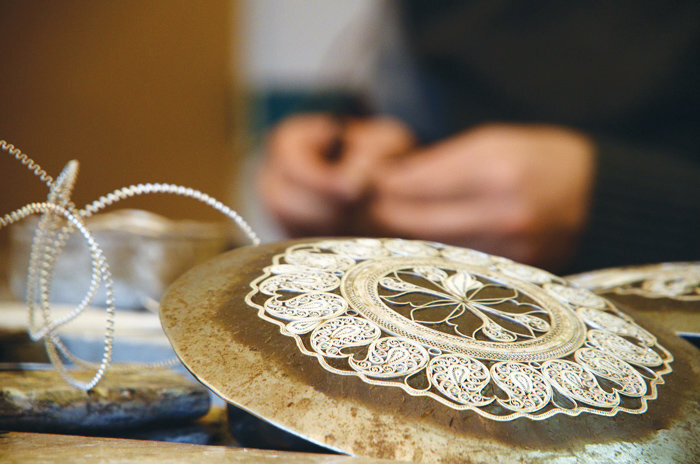Iranian handicrafts on show at Zanjan exhibit

TEHRAN –Collections of Iranian handicrafts and traditional arts are on display in an exhibition, which is currently underway in Zanjan, the provincial tourism chief has said.
Artisans and crafters from 12 provinces across the country have participated in the four-day sales exhibition, Amir Arjmand announced on Wednesday.
It is important to hold such exhibitions during the outbreak of the coronavirus as it will benefit the handicraft industry and introduce travel and sales methods during the pandemic, the official added.
Organized by the province’s Cultural Heritage, Tourism and Handicrafts Department, the exhibit is running following strict health protocols and social distancing rules, he explained.
Zanjan is known for exquisite handmade products including knives, Giveh (a kind of traditional footwear), copper dishes, and filigree.
Knifemaking is one of the oldest handicrafts practiced for centuries in several Iranian cities, of which the northwestern city of Zanajn is the most famous.
Knives, swords, and daggers were produced and a lot of knife-making workshops were active in these cities. But due to their design, cut, diversity, and durability, Zanjan knives have been the most successful.
This traditional footwear of Giveh, which is produced in the Iranian plateau for millennia, is very light and durable. However, it was more common in the past and was worn by farmers and villagers. This clothing has very unique features. For example, it is highly suitable for arid and mountainous climates, it is very light which decreases the sweating of the feet. It does not have a left foot or right foot, both of them are the same. These features have given the footwear international popularity and made it a unique product.
In the past, giveh did not have specific sizes, but they were made in 3 general sizes of small, medium, and large. They are most commonly white. However, sometimes the craftsman makes them in colors like blue, red, or black based on his own taste or at the request of the buyer.
Hand-made copper dishes are very popular in the central province of Isfahan and Zanjan. In addition to being useful for human health, these products can also be used as decorative pieces and are considered to be superb works of art.
In January 2020, Zanjan was designated as a “world city of filigree” by the World Crafts Council after the WCC assessors visited various craft workshops, stores, exhibits, and bazaars of the city in a two-day itinerary.
Filigree consists of curling, twisting, or plaiting fine, pliable metal threads and soldering them at their points of contact with each other with metal groundwork.
Zanjan makes a base for wider explorations with the architectural wonder of Soltaniyeh, the subterranean delights of the Katale-Khor caves, colorful mountains, and the UNESCO-registered Takht-e Soleiman ruins are nearby.
With 14 entries, Iran ranks first globally for the number of cities and villages registered by the World Crafts Council, as China with seven entries, Chile with four, and India with three ones come next.
The value of Iran’s handicrafts exports stood at $120 million during the first eleven months of the past Iranian calendar year 1399 (March 20, 2020 – February 18, 2021), Mehr reported. The country’s handicrafts exports slumped during the mentioned months in comparison to the same period last a year earlier due to the damage the coronavirus pandemic has inflicted on global trade.
The Islamic Republic exported $427 million worth of handicrafts during the first eleven months of the calendar year 1398. Of the figure, some $190 million was earned via suitcase trade (allowed for customs-free and tax-free transfer) through 20 provinces, according to data compiled by the Ministry of Cultural Heritage, Tourism and Handicrafts.
Ceramics, pottery vessels, handwoven cloths as well as personal ornamentations with precious and semi-precious gemstones are traditionally exported to Iraq, Afghanistan, Germany, the U.S., the UK, and other countries.
ABU/
